Rehab Technology
Helen Hayes Hospital offers a wide array of treatment options utilizing state-of-the-art rehabilitation technology.
Learn more about some of the cutting edge pieces of rehab tech available at HHH:
 At Helen Hayes Hospital, we harness the power of the AlterG Anti-gravity Treadmill® to lighten the load of weight-bearing activity, helping individuals regain mobility, develop strength and fitness, and increase the range of motion while minimizing stress on their injuries.
At Helen Hayes Hospital, we harness the power of the AlterG Anti-gravity Treadmill® to lighten the load of weight-bearing activity, helping individuals regain mobility, develop strength and fitness, and increase the range of motion while minimizing stress on their injuries.
The AlterG Anti-gravity Treadmill® uses innovative, patented NASA technology that can reduce an individual’s body weight from 100% to as low as 20% of the user’s weight in 1% increments. This “unweighting” is achieved by gently filling up a chamber fitted around the user’s midsection with air to the user’s desired body weight, resulting in a treadmill experience described by users as “running on air” or “walking on the moon.” Users are securely contained in the treadmill’s adjustable air chamber, allowing for a fall-safe environment.
The AlterG Anti-gravity Treadmill® can be used as a physical therapy aid for individuals who have had an injury or surgery on a lower extremity or a total joint replacement. It can also aid in gait training and strengthening for individuals with Parkinson’s Disease, stroke, traumatic brain injury and other neurological conditions. The AlterG provides all of these therapies in a fall-safe, weight-reduced environment, providing injury prevention while also increasing strength, balance, and mobility.
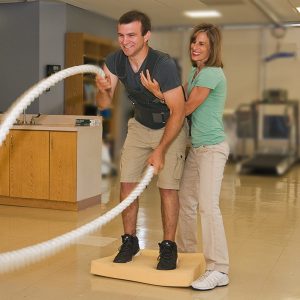 The BalanceWear ® BW300 is a custom fitted vest with strategically placed light weights to accommodate for balance impairments. At Helen Hayes Hospital a skilled therapist trained in the BalanceWear vest will be able to perform a comprehensive balance assessment and determine appropriateness for therapy. As part of the therapeutic intervention, patients would utilize the vest during therapy and work towards achieving a personal vest for home use, pending benefits of use.
The BalanceWear ® BW300 is a custom fitted vest with strategically placed light weights to accommodate for balance impairments. At Helen Hayes Hospital a skilled therapist trained in the BalanceWear vest will be able to perform a comprehensive balance assessment and determine appropriateness for therapy. As part of the therapeutic intervention, patients would utilize the vest during therapy and work towards achieving a personal vest for home use, pending benefits of use.
The BalanceWear vest is crafted to hold a number of strategically placed light weights on its interior shell based on the individuals postural and balance needs. The goal of the vest is to correct for multi-directional balance deficits and aide in improved mobility.
Individuals with a varied number of conditions can benefit from wearing the BalanceWear vest, including those with balance and mobility loss due to Parkinson’s Disease, multiple sclerosis, stroke, traumatic brain injury, osteoporosis, ataxia, cerebral palsy, dizziness and advanced age.
 To maintain balance, our brains must make sense of complex interactions between our visual, sensory and vestibular systems. When one of more of these systems become impaired due to disease, injury or aging, our ability to maintain balance also becomes impaired, resulting in a higher risk of falls.
To maintain balance, our brains must make sense of complex interactions between our visual, sensory and vestibular systems. When one of more of these systems become impaired due to disease, injury or aging, our ability to maintain balance also becomes impaired, resulting in a higher risk of falls.
At Helen Hayes Hospital, the Bertec Balance Advantage ™ is employed as a highly-effective method to assess and treat balance deficits in individuals affected by dizziness, vertigo, vestibular disorders, Parkinson’s Disease, stroke, traumatic brain injury, neuro-degenerative diseases, lower limb amputation and more.
Offering the latest technology in Computerized Dynamic Posturography, the Bertec Balance Advantage utilizes an immersive virtual reality screen, a safety harness, and dual force balance plate to objectively quantify and differentiate among a variety factors influencing an individual’s static and dynamic balance. Under the supervision of a certified therapist, the individual can then safely work on the Bertec Balance Advantage to reach his or her balance goals, tracking their progress along the way.
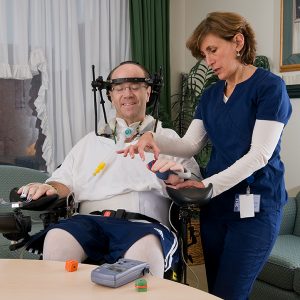 The NESS H200 ™ is an addition to the many treatment modalities utilized by occupational therapists at Helen Hayes Hospital. A neuroprosthetic and rehabilitation system distributed by Bioness, Inc., the NESS H200 facilitates improved motor control and function for individuals with stroke, acquired brain or spinal cord injury or other disorders of the central nervous system resulting in impairments of the arm or hand. When there is little or no movement in a hand, this device can give survivors hope and potentially more function.
The NESS H200 ™ is an addition to the many treatment modalities utilized by occupational therapists at Helen Hayes Hospital. A neuroprosthetic and rehabilitation system distributed by Bioness, Inc., the NESS H200 facilitates improved motor control and function for individuals with stroke, acquired brain or spinal cord injury or other disorders of the central nervous system resulting in impairments of the arm or hand. When there is little or no movement in a hand, this device can give survivors hope and potentially more function.
The device is a portable, custom-fit wrist/hand orthosis (splint). It is noninvasive and functions utilizing a microprocessor that activates the muscles of the forearm and hand. The H200 can be used in two different ways: as a therapeutic modality to assist in improving the motor recovery of a weak or paralyzed hand, or as a functional tool for performing activities of daily living. It can also provide other benefits, such as increased range of motion, reduced stiffness, increased local blood circulation, improved awareness of the limb, reduced spasticity and muscle re-education.
Use and training are initiated during either inpatient or outpatient therapy by certified occupational therapists. Ultimately, the goal is for patients to use the device in a therapy-directed home program. Progress will be monitored at regular intervals and the program will be revised to maximize continuing progress. A typical outpatient program would be 12-16 sessions with periodic follow-ups.
Patients may continue to use the H200 as long as they are showing improvements in function and those with chronic disabilities may use the device for the rest of their lives to manage or minimize their impairments.
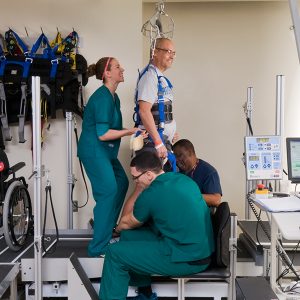 Advances in research suggest that functional neuro-recovery offers tremendous potential in rehabilitation medicine. The rewiring of neural pathways or the recruitment of new pathways to control movement offer hope for the restoration of function following traumatic injury.
Advances in research suggest that functional neuro-recovery offers tremendous potential in rehabilitation medicine. The rewiring of neural pathways or the recruitment of new pathways to control movement offer hope for the restoration of function following traumatic injury.
To harness this potential, HHH offers body weight supported gait training using the state-of-the-art TheraStride system. The training is available to both inpatients and outpatients with incomplete spinal cord injury, as well as to patients with traumatic brain injury and stroke and other neurological conditions.
We now know that the central nervous system is malleable and can still adjust and relearn post-injury. Body weight supported gait training is an activity-based rehabilitative strategy that provides the sensory experience of walking, with the goal of re-training neural pathways, ultimately resulting in ambulation.
The TheraStride combines a support harness system and a treadmill with computer software that measures and evaluates the patient’s progress. Trained physical therapists provide the necessary manual assistance, facilitating extension of the hip, knee, and ankle. Following step training using body weight support on a treadmill, the patient then progresses to over-ground walking training and finally to community ambulation training.
This training helps to improve balance, motor control, weight-bearing ability and the re-creation of a natural gait. It also increases endurance and speed.
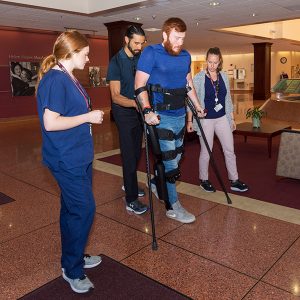 Imagine someone not being able to walk for years and then suddenly a groundbreaking piece of equipment comes along and allows that person to walk again. That is what the ReWalk is capable of and HHH is one of a select few rehab facilities nationwide utilizing this state-or-the-art equipment.
Imagine someone not being able to walk for years and then suddenly a groundbreaking piece of equipment comes along and allows that person to walk again. That is what the ReWalk is capable of and HHH is one of a select few rehab facilities nationwide utilizing this state-or-the-art equipment.
The ReWalk began in Israel and has since gone international, developing a new, innovative technology that combines robotics with human assistance to make walking possible when previously impossible. The technology includes a battery-housed backpack plus two robotic uprights that are worn around the individual’s legs. While using two crutches for balance, the individual is able to shift his or her body from side to side. This critical weight shift provides the command for the ReWalk to detect which leg is taking a step and which leg is staying straight.
But what about going from a sitting position to a standing position? What about doing stairs? No problem! The individual wears a small wristband that looks like a watch, but functions like a remote. It has three buttons for multiple commands: sit, stand, walk, ascend stairs, and descend stairs. By using this wrist band the individual can independently transition between all modes to access his or her home and community.
Benefits of exoskeleton therapy and use include restored independence, increased psychological well-being, improved overall health and fitness and reduced complications from spinal cord injury, including thinning of the bones, pressure sores and bowel and bladder disorders.
HHH physical therapy staff are trained and educated on this new shift in physical therapy practice. Any adult who has some type of leg impairment that impacts his or her upright mobility can use the ReWalk. The individual needs appropriately functioning hands, arms and shoulders. Each patient must be seen by a physician for approval to use the ReWalk.
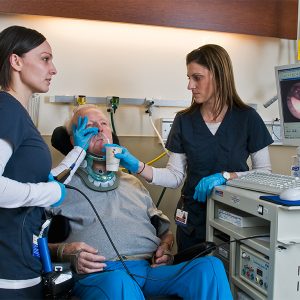 Speech-language pathologists at HHH now offer Flexible Fiberoptic Endoscopic Examination of Swallowing, or FEES. The non-radioactive examination allows for the direct visualization of the pharyngeal and laryngeal structures in order to assess an individual’s swallowing function.
Speech-language pathologists at HHH now offer Flexible Fiberoptic Endoscopic Examination of Swallowing, or FEES. The non-radioactive examination allows for the direct visualization of the pharyngeal and laryngeal structures in order to assess an individual’s swallowing function.
FEES is a valuable tool that enables a trained speech-language pathologist to evaluate a patient’s swallowing impairment, determine the best intervention, measure the effects of treatment and identify appropriate dietary modifications.
The procedure may also be used as a therapeutic tool by providing visual feedback to show patients the effects of utilizing different swallowing maneuvers.
Individuals who report trouble or pain while swallowing are candidates for FEES, including patients with stroke or traumatic brain injury or spinal cord injury. In addition, patients who experience persistent coughing or throat clearing during meals, patients with tracheotomy or patients with a history of swallowing difficulty related to progressive neurological disorders can also benefit.
FEES is a safe, reliable, and effective tool for the management of swallowing disorders and is available at HHH for both inpatients and outpatients.
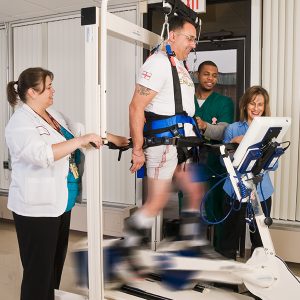
State-of-the-art Functional Electric Stimulation (FES) equipment is currently helping many patients at Helen Hayes Hospital regain their strength and cardiovascular fitness. While FES technology has been around for more than thirty years, recent advances have made the equipment much more user-friendly. Physical therapists, who have received specialized training in the use of the equipment, including how to monitor the settings to ensure maximum benefit to the user, use the FES bicycle with inpatients and outpatients.
FES technology can help people with many levels of disability, including those with multiple sclerosis, spinal cord injury, brain injury, Parkinson’s Disease, stroke and other conditions. It is also being used to help children with cerebral palsy improve their motor skills.
This high-tech bicycle provides patterned electrical stimulation to the surface of muscles, enabling adults and children as young as four to work their muscles. Surface electrodes are placed on one or both sides of the patient’s upper or lower body by the therapists. The electrodes are then connected to the computerized brain of the machinery that controls speed and resistance. It also measures the amount of effort the cyclist is exerting and automatically measures each patient’s progress.
Even patients who have lost voluntary control over their muscles due to spinal cord injury are able to bicycle with the help of the FES system. Patients can even use the FES equipment without transferring from their wheelchairs. The exercise relaxes spasms, improve circulation, maintains or increases range of motion, and prevents muscle atrophy that often accompanies lack of use.
Once patients leave the hospital to return home, they can access FES as an outpatient, or even obtain the equipment for home use. With computerized connections, the patient’s safety can be monitored and through feedback, resistance and stimulation can be adjusted remotely. Medicare now covers FES therapy for patients with spinal cord injury.
For more information about the outpatient FES Program at Helen Hayes Hospital, call (845) 786-4799.
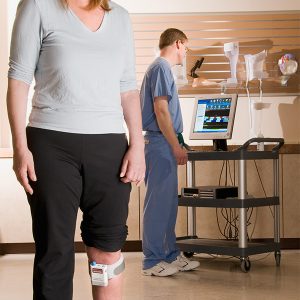 Individuals with neurological disorders, such as multiple sclerosis, stroke or spinal cord injury, often have difficulty walking. Specifically, they may have a condition called Foot Drop, which is characterized by weakness or paralysis of the muscles that control the foot. This may result in the foot or the toe of the shoe being dragged on the ground, making walking uncomfortable or even impossible.
Individuals with neurological disorders, such as multiple sclerosis, stroke or spinal cord injury, often have difficulty walking. Specifically, they may have a condition called Foot Drop, which is characterized by weakness or paralysis of the muscles that control the foot. This may result in the foot or the toe of the shoe being dragged on the ground, making walking uncomfortable or even impossible.
A new Neuro Prosthetic device called the WalkAide is designed to restore a smoother, more natural gait, enabling users to walk faster, for longer distances with less fatigue. The device is now available through the hospital’s Prosthetic Orthotic Center, which became certified in fitting, customizing supplying the WalkAide for patient use.
The WalkAide utilizes functional electrical stimulation to restore the nerve-to-muscle signal in the leg and foot. Walking becomes a smoother, safer and more natural motion. Basically, the gentle electrical impulses activate the muscles to raise the foot at the appropriate time.
The small, easily operated device is battery operated, with two electrodes and electrode leads. It is applied directly to the leg with a cuff holding it comfortably in place. The WalkAide can be worn discreetly under clothing. It also permits walking barefoot, something that cannot be done with conventional bracing. The WalkAide may improve not only gait, but also circulation and joint range of motion.
For additional information, contact the Prosthetic Orthotic Center at 845-786-4122.
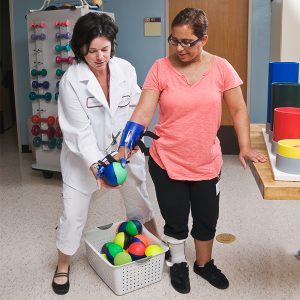 Depending on the location and the severity of a stroke, occupational therapists have typically been able to provide treatment that has improved a clients’ shoulder and elbow movements, however, the hand has presented more of a challenge. When a client presents with a tight fisted hand, therapists have had limited treatment options and success with making the hand more functional – until now.
Depending on the location and the severity of a stroke, occupational therapists have typically been able to provide treatment that has improved a clients’ shoulder and elbow movements, however, the hand has presented more of a challenge. When a client presents with a tight fisted hand, therapists have had limited treatment options and success with making the hand more functional – until now.
With the SaeboFlex, a client can grasp and release objects for the first time since their stroke, providing them with new hope for improved function in their arm. The device and treatment makes functional tasks, such as dressing and feeding oneself possible.
The SaeboFlex is a mechanical, dynamic hand orthosis that is utilized to enable a person to incorporate their involved hand into grasp and release activities. It works based on a spring release system that positions the hand in the open, extended position. During therapy, the client then utilizes his or her increased muscle tone to squeeze a ball. Once the client relaxes, the springs move the fingers back into an extended position, allowing the client to drop the ball in a designated location. The client then reaches for the next ball and completes high repetitions of grasp and release activities.
This high repetition helps to improve the strength throughout the arm and generates more cortical (brain) involvement. Over the course of therapy, the client learns to control the increased muscle tone in their hand so they can regain functional use of their involved hand. Clients are encouraged to use the device at home, reinforcing their therapy.
A unique and valuable aspect of SaeboFlex treatment is that it can help individuals who are up to 20 years post injury. The length of time since the onset of injury does not matter, as long as the client meets certain criteria. The most appropriate clients are those who are unable to open their hand, but have some shoulder and elbow movement. The device is also helpful for individuals who have had a traumatic brain injury or other neurological condition. The device is primarily used on an outpatient basis.
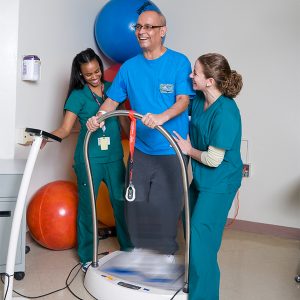 Vibration therapy is a type of neuro-muscular re-education, a treatment technique or exercise performed by an individual with the purpose of improving, via the nervous system, the level of communication between the body and the brain.
Vibration therapy is a type of neuro-muscular re-education, a treatment technique or exercise performed by an individual with the purpose of improving, via the nervous system, the level of communication between the body and the brain.
Because side-alternating vibration training and vibration therapy exercises rely on the involuntary stretch reflex, there is a significant amount of communication occurring between the brain and the contracting muscles with each individual exercise. The goal is to “jump start” the muscle contraction through the intense high-repetition rate called frequency, thereby enhancing the patient’s ability to efficiently recruit the muscle fibers, coordinate movement being performed by the joint and muscle tissue.
Vibration therapy is used to help increase bone density, reduce spasms and build muscle tone in people who have suffered spinal cord injuries, as well as individuals who have had strokes. Side-alternating vibration treatment optimizes “motor relearning” under the principle of repetition; it’s easy to use, promotes early rehabilitation and provides efficient therapy in a short period of time. While there are many studies at this point, more research is needed on the long-term effects of whole body vibration.
Helen Hayes Hospital uses a vibration therapy system called Galileo-Training. The principle of Galileo is based on the natural movement of human gait. Galileo’s side-alternating motion is similar to a seesaw movement with variable amplitude and frequency, and therefore stimulates a movement pattern similar to human gait. The rapid movement of the training platform causes a tilting movement of the pelvis, just like when walking, but much more frequently. To compensate, the body responds with rhythmic muscle contractions, alternating between the left and right side of the body. A training session of three minutes at 25 hertz therefore causes the same number of muscle contractions as walking a distance of 4,500 steps.
It’s not meant to be a total training method, but as an adjunct it can be extremely beneficial. Galileo-Training puts minimum stress on the cardiovascular system, helps to increase blood circulation and metabolism. It also offers pelvic floor training, improved flexibility and range of motion, relief from back pain and improved balance and coordination.
A swallowing disorder, more commonly referred to as dysphagia (dis-fah-jah), occurs when there is a problem with any part of the swallowing process from the mouth to the stomach. Some symptoms may include coughing and/or choking during or after swallowing, pain or a sensation of food getting stuck in the throat and shortness of breath while eating. Recent research has concluded that dysphagia effects as many as 15 million Americans, with 1 million being newly diagnosed each year.
Dysphagia can arise from a wide variety of causes including stroke, traumatic head or spinal cord injuries, head/neck/esophageal cancers, degenerative neurological conditions (Parkinson’s Disease, ALS, MS, Myasthenia Gravis), respiratory conditions (Chronic Obstructive Pulmonary Disease) and tracheotomies. Dysphagia can have devastating side effects if not diagnosed and managed properly. The most severe is aspiration pneumonia, which is when saliva, food or liquid enters the airway and goes into the lungs. Aspiration pneumonia is a serious condition and has been cited for being one of the leading causes of death among the elderly. Other side effects of dysphagia may include choking, weight loss, chronic malnutrition, bronchospasm, physical de-conditioning and depression.
There are a wide variety of treatment methods utilized to treat swallowing disorders but one that is highly supported by clinical research is VitalStim Therapy (VST), which is a modified form of neuromuscular electrical stimulation (NMES) that has been designed to specifically treat dysphagia through muscle re-education. NMES is a type of therapy that has been used for many years by physical therapists to retrain the larger muscles in the body, such as the arms and legs. VitalStim Therapy is the only NMES device that is cleared by the FDA as a “safe and effective” treatment method for swallowing disorders.
VST uses non-evasive small electrical currents to stimulate and re-educate the inactive or atrophied muscles of swallowing. This treatment is conducted by a trained speech-language pathologist and should be used in conjunction with traditional therapeutic methods. The only side effect reported with VST is minor redness or irritation of the skin where the electrodes were placed.
VitalStim Therapy is safe, effective, painless and clinically proven treatment method that can improve a person’s quality of life.
